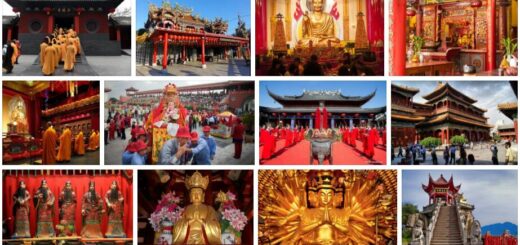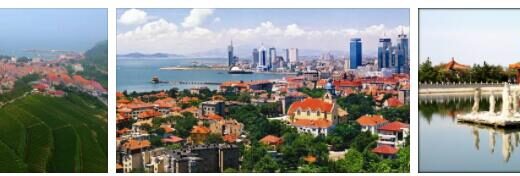Karst Landscape in Southern China (World Heritage)
The southern Chinese, humid subtropical karst region extends over an area of 0.5 million km² in the provinces of Yunnan, Guizhou and Guangxi. The landscape is of great beauty and contains, among other things, the “stone forests” of Shilin with the Naigu and Suyishan stone forests. Erosion has shaped the limestone into tower and cone-shaped figures and created a landscape that is unique in the world.
Karst landscape in southern China: facts
| Official title: | Karst landscape in southern China |
| Natural monument: | Spectacular weathered limestone formations in an area of nearly 600,000 km² in southern China; three areas as world natural heritage: Shilin, Libo and Wulong; Shilin (Yunnan): stone forests formed 300 million years ago with bizarre sculptures (partly named because of their formations reminiscent of people and animals) and carts (the most common small form of the karst) in a wide variety of shapes (e.g. pagoda, mushroom, columnar crenellated); Libo (Guizhou): Limestone cliffs from different ages with conical and tower karsts, water caves and deep sinkholes (bowl or funnel-shaped hollow forms) as well as a great diversity of species; Wulong (Chongqing): Inland karst plateau on the Wujiang River with huge sinkholes and bridge formations; in some places special, |
| Continent: | Asia |
| Country: | China |
| Location: | Yunnan Provinces, Guizhou, Chongqing, South China |
| Appointment: | 2007, expanded in 2014 |
| Meaning: | Outstanding natural phenomenon with an impressive effect; globally unique, extraordinarily diverse karst rock formations; Example of a specific cultural development of a region adapted to the natural living conditions |
A fairy tale forest made of stone
They form an extraordinary landscape in southern China: the cone-shaped and tower-shaped karst mountains that can be found in large parts of the southern Chinese mountains. No two karst formations are alike: sometimes the limestone cliffs are conical, sometimes they form into forests of rock needles; they have the most varied of shapes, form natural bridges and caves, and are crossed by rivers and waterfalls. With its almost mystical appearance, the southern Chinese karst landscape is one of the greatest natural wonders in the world.
More than 270 million years ago, the landscape in southern China was still below sea level. In this primeval sea, layers of various compositions were gradually deposited, mainly made of very pure limestone, which eventually grew to a thickness of 500 meters. In the course of a very long geological process, the land rose and the water receded. About two million years ago, the forces of strong chemical weathering and erosion set in, which have a particularly intense effect in southern China in a subtropical to tropical climate with high levels of precipitation. In the course of time, a low mountain range emerged in which ridges, ridges and valleys deeply cut by the rivers alternate with each other.
This part of the UNESCO World Natural Heritage is located 120 kilometers southeast of the city of Kunming in the southern Chinese province of Yunnan. In an area of 350 square kilometers there are natural limestone sculptures up to 30 meters high, which soar high into the sky like gray trees. They are connected by artificial paths so that you can wander through the stone forests like a gigantic labyrinth – and get lost in it. The needle-, column-, mushroom- and pagoda-shaped rocks are often reminiscent of people, animals or plants; Numerous lakes such as the Changhusee, ponds, a large waterfall and underground rivers give the landscape a special charm.
Hundreds of conical hills rise in the Libo Karst landscape, an area covered by lush subtropical forests near Guiyang in Guizhou Province. It lies at an altitude of 385 to 1109 meters. There you can see how the karst forms change during the transition from the lowlands of Guangxi to the high plateau of Guizhou. In addition to the well-formed cones and bizarre towers, crystal-clear rivers and lakes, waterfalls and caves make this region particularly attractive. Among other things, the Xiangshuihe waterfall is noteworthy. The karst landscape of Wulong is located in the northwest of the Hunan Province near the city of Chongqing. The Wu Jiang, a tributary of the Chang Jiang, has cut a 79-kilometer-long and up to 1,000-meter-deep gorge into a mountain landscape between 1200 and 2000 meters above sea level. On an area of 264 square kilometers, 3100 towers made of quartz sandstone, which are between 100 and 400 meters high, crowd this karst landscape. In this unique fairytale forest with karst caves, karst funnels, natural bridges, shafts, stone forests, stalactites, underground lakes and rivers, geysers and hot springs, visitors often feel like they are in a completely different world. One of the most famous rock formations in Wulong are the three natural bridges of Sanqiao. One of them connects two rock faces over a length of 40 meters and spans a 357 meter deep abyss. This makes it the tallest natural bridge in the world. The Furong Jiang karst region impresses with gorges and caves. The Furong Cave (Hibiscus Cave) is a stalactite cave. It was only discovered in 1993 and opened to visitors two years later. It is 2700 meters long and has chambers that are up to 80 meters high. In the 11,000 square meter “Hall of Fame” there are impressive stalagmites and stalactites. Many stalactite formations also form unusual shapes such as flowers or palms. A 15 meter wide stone waterfall falls 21 meters down there. Another waterfall that falls 100 meters deep is fed by underground rivers. Another common formation in this area are huge karst funnels or sinkholes (Tiankeng). A particularly impressive karst funnel is the Tiankeng of Houping. The cylindrical shaft has a diameter of 300 meters and is just as deep. At its bottom there are caves with other tiankengs.
According to estatelearning, the breathtaking rock formations are the main attraction of the southern Chinese karst landscape, but the tropical and subtropical regions also fascinate with their extraordinarily rich flora and fauna. Around 3000 plants, including extraordinary orchid species, are gathered there, as well as many rare animal species such as the Chinese musk deer and the Chinese giant salamander, which is up to 1.50 meters long. The fact that large parts of the landscape are still covered by lush forests is thanks to the karst mountains: Since they are close together, it is not worth clearing the forests and creating fields.



